Prevalence and Antibiotic Susceptibility Profile of Fecal Coliform Isolated from Beverage Sold in Sangkhalok Community
Main Article Content
Abstract
Objectives: The aims of this study were: 1) to assess the microbial quantity of beverages sold in Sangkhalok community, 2) to establish the prevalence of fecal coliforms in beverages, and 3) to study the antimicrobial susceptibility pattern of fecal coliform in beverages
Methods: Thirty-six sample beverages sold in Sangkhalok community were collected. They were tested for the presence of fecal coliforms using the multiple tubes fermentation technique (MPN). Fecal coliforms from contaminated beverages were isolated and identified by using biochemical testing. Antimicrobial susceptibility tests were performed with eight antibiotic agents by agar disk diffusion.
Results: Of 36 samples, 50%, including ice 72.22% (13/18) and cold beverages 27.78% (5/18), were contaminated with fecal coliform at above standard level. A total 164 fecal coliforms were isolated and identified as Klebsiella pneumoniae (62.80%), Escherichia coli (31.71%), and other coliform (5.49%). Susceptibility testing against to eight antibiotic agents showed that fecal coliform were highly resistant to ampicillin (18.90%), trimethroprim/sulfamethoxazole (9.76%), ciprofloxacin (9.15%), and cefotaxime (7.32%). Seven isolates were regarded as extended-spectrum beta-lactamase producing bacteria. We reported the presence of multidrug resistance fecal coliforms in beverages.
Conclusion: The current study revealed that contaminated beverages accounted for upto 50% of all beverages. Ice was the most contaminated with coliforms. All hot beverages met the standard microbiological criteria. The most common coliform was identified as Klebsiella pneumonia and Escherichia coli which were multidrug resistant and ESBL-producing bacteria. This study provided data to promote awareness and to set policies to monitor for the prevention of widespread antibiotic-resistant fecal coliforms in the community
Downloads
Article Details
References
2. ปิยะรัตน์ ภูมิโคก. การปนเปื้อนของอาหาร น้ำดื่ม และภาชนะ ในสถานสงเคราะห์เด็กกรุงเทพมหานครและปริมณฑล [วิทยานิพนธ์ปริญญาวิทยาศาสตรมหาบัณฑิต]. กรุงเทพฯ: จุฬาลงกรณ์มหาวิทยาลัย; 2547.
3. ดาริวรรณ เศรษฐีธรรม, เนตรนภา เจียระแม. สถานการณ์การปนเปื้อนจุลินทรีย์ในน้ำดื่ม เครื่องดื่ม และภาชนะที่ให้บริการในโรงพยาบาลส่งเสริมสุขภาพตำบล จังหวัดมหาสารคาม. วารสารวิจัยสาธารณสุขศาสตร์ มหาวิทยาลัยขอนแก่น 2555; 3: 87-96.
4. นัยนา หาญวโรดม, นัยนา ใช้เทียมวงศ์ และชัยเลิศ กิ่งแก้วเจริญชัย. ของเชื้อจุลินทรีย์ใน เครื่องดื่มที่จำหน่ายในศูนย์อาหารของห้างสรรพสินค้า. กรุงเทพฯ: กองสุขาภิบาลอาหาร และน้ำ กรมอนามัยกระทรวงสาธารณสุข: 2548.
5. อาซามะ ตาหมี่. การตรวจวิเคราะห์หาปริมาณ Coliform Bacteria และ Escherichia coli ในน้ำแข็งที่จำหน่ายในตำบลบ้านดู่ อำเภอเมืองเชียงราย. เชียงราย: โปรแกรมวิชา ชีววิทยาประยุกต์ คณะวิทยาศาสตร์และเทคโนโลยี มหาวิทยาลัยราชภัฏเชียงราย: 2548.
6. สำนักสารนิเทศ สำนักงานปลัดกระทรวงสาธารณสุข. กรมวิทย์ฯ เผยผลตรวจเครื่องดื่มในโรงเรียนทั่วประเทศ [อินเทอร์เน็ต]. กรุงเทพฯ: สำนักสารนิเทศ สำนักงานปลัดกระทรวงสาธารณสุข; 2551 [เข้าถึงเมื่อ 18 ต.ค. 2557]. เข้าถึงได้จาก:http://www.moph.go.th/ops/iprg/include/admin_hotnew/show_hotnew.php?idHot_new=29251.
7. กลุ่มสื่อสารสาธารณะและภาคีเครือข่ายสำนักโรคติดต่อทั่วไป. การรับประทานน้ำแข็งอย่างปลอดภัยในช่วงฤดูร้อน[อินเทอร์เน็ต]. สุรินทร์: กลุ่มสื่อสารสาธารณะและภาคีเครือข่ายสำนักโรคติดต่อทั่วไป; 2557 [เข้าถึงเมื่อ 18 ต.ค. 2557]. เข้าถึงได้จาก: thaigcd.ddc.moph.go.th/informations/view/365.
8. Ball AR, Casadei G, Samosorn S, Bremner JB, Ausubel FM, Moy TI, et al. Conjugating berberine to a multidrug efflux pump inhibitor creates an effective antimicrobial. ACS Chem Biol. 2006; 1(9): 594-600.
9. Badura A, Luxner J, Feierl G, Reinthaler FF, Zarfel G, Galler H, et al. Prevalence, antibiotic resistance patterns and molecular characterization of Escherichia coli from Austrian sandpits. Environ Pollut. 2014; 194: 24-30.
10. ปิยะรัตน์ จิตรภิรมย์. การศึกษาความชุกของแบคทีเรียชนิดที่สร้างเอนไซม์บีตาแลคทาเมสที่มีฤทธิ์ขยาย จากแหล่งน้ำสิ่งแวดล้อม. ก้าวทันโลกวิทยาศาสตร์ ปีที่ 12. 2555(2):94-106.


